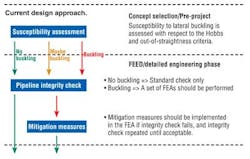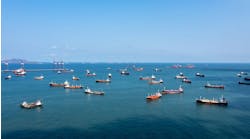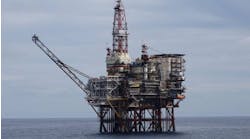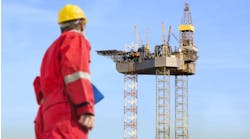Americo Fernandes
Sonangol
Alexandre Cinello
Alain Dorbec
Pierre-Yves Le Lay
DORIS Engineering
The high temperatures and pressures which occur in subsea flowlines induce large compressive axial forces in the pipe wall. With the flowline acting as a bar, its natural tendency is to relieve the resulting compressive force by buckling. In deepwater and relatively flat seabed, non-trenched flowlines buckle horizontally. This phenomenon may have consequences for the integrity of the flowline if there is an uncontrolled and large buckle. It also can be an attractive solution to relieve axial compressive forces.
Today, production activities in deeper waters often lead to the discovery of higher temperature and high-pressure fields. These conditions increase the susceptibility of flowlines to lateral buckling and require the development of practicable mitigating measures. This adds complexity to the study of lateral buckling.
Designers have two types of tools to analyze this phenomenon. One is an analytical tool, the so-called "Hobbs Method." However, due to the assumptions on which it is based, this model can be too conservative. Finite element analysis (FEA) models are the other tool. Their main disadvantages are that they are time consuming; and sensitive to the initial assumptions and input data, requiring qualified personnel behind the screen.
As part of an effort to improve oil development offshore Angola, the Angola Deepwater Consortium (ADC), formed by Sonangol and Doris Engineering, investigated the feasibility of developing a new analytical tool based on an improvement of the Hobbs Method. This study was performed with the guidance and inputs of a JIP Steering Committee composed of representatives and experts from BP, CABGOC, Esso Exploration Angola (Block 15) Ltd., Eni, Petrobras, and Total E&P Angola.
Initial state-of-the-art review confirmed the need for the development of a new analytical method as an alternative to existing methods. The goal was to develop a tool that could be used in the early stages of concept selection, as well as during operations, to quickly respond to integrity management issues during service life.
The development of this tool was based on the improvement of the existing Hobbs Method, and validated against FEA results computed on Abaqus software.
Current design approach
The design approach currently used to address the lateral buckling issues seems to depend mainly on the project phase, and is provided by two recommended practices:
- DNV RP F110: Global Buckling of Submarine Pipeline
- Safebuck approach developed during the Safebuck JIP.
During the concept selection/preproject phase, an analytical method is used to assess the susceptibility of a flowline to lateral buckling. The method also identifies whether further studies involving FEA are required at the next step of development.
Development objectives
Based on this, the objective was to improve the current analytical method to develop a user-friendly and fast answer tool to propose an alternative, or to complement the FEAs at different phases of an offshore development.
The identification of potential improvements was based on two observations:
- Pipeline/soil interaction is a key in the lateral buckling phenomenon and requires accurate modeling
- More flowlines are being installed with mitigating systems in place (snake-lay, buoyancy modules, and sleepers are the three most frequently installed solutions). The tool should allow engineering and operations personnel to analyze them.
Consequently, improvements in the analytical method need to include the following:
- Lateral soil resistance varying with pipeline lateral displacement
- Axial soil resistance varying with pipeline axial displacement
- Multiple buckles option to model adjacent buckles (snake lay) with the concept of virtual anchor spacing (VAS)
- Localized pipeline weight reduction to model the effect of buoyancy modules
- Localized pipeline/soil resistance reduction to model the effect of sleepers.
Comparison against FEA
The initial objective of the study was to compare and validate the improved analytical method against actual behavior of some existing pipelines recorded by the different oil companies during various inspection or survey campaigns. However, the amount of available pipeline survey data was insufficient. It would have allowed comparison, but not full validation of the improved model. Consequently, the new analytical method has been compared and validated against the FEA tool Abaqus. This comparison is based on the analysis of more than 200 cases.
First, a basic FEA model was built based on the same assumptions as the Hobbs's theory to ensure model adequacy and to build a reference FEA model. Comparison between these two models provided the study team with an estimate of the deviations between Hobbs and FEA.
Then, each improvement of Hobbs was introduced step by step and in parallel in the FEA model. At each step, two types of comparison were performed:
- Quantitative comparison of the main buckle characteristics (compressive force within the buckle, buckle length and maximum amplitude, maximum bending moment, and maximum strain within the buckle)
- Qualitative comparison of results when some key input parameters are varied for each model.
Then, the FE model computations were done in three steps:
- 1. Weight and external pressure is applied to the pipeline. In addition, a small lateral displacement of the middle node is imposed to initiate the buckle. Because an impact of this initial imperfection on the final buckle shape has been observed, it was decided to perform each computation with two different initial imperfection amplitudes (0.5 and 2 m).
- 2. Internal pressure is applied to the pipeline
- 3. Temperature field is applied.
During this project only the mode-three buckle was generated in the FEA. Consequently, all comparisons were performed on mode-three buckle shapes. In addition, different sensitivity studies were performed to study the impact of mesh size, software convergence options, pipe element models, and initial imperfection.
Comparison conclusions
The first comparison was based on the time required to set-up and run a model. This showed that the "user friendly" aspect of the improved analytical tool makes it more suitable for the following:
- Screening studies at early stages of pipeline engineering (concept selection)
- Analysis of as-builts or selection of mitigation measures so as to quickly respond to pipeline integrity management issues during service life.
The second comparison was based on a batch of around 200 cases computed both with the improved analytical model and Abaqus.
The computed cases included:
- Four different pipeline configurations: Outside diameter from 10-in. to 26-in., wall thickness from 0.013 to 0.027 m, submerged weight from 597 to 3162 N.m-1
- Different conditions: Temperature from 20 °C to 80 °C and pressure from 60 to 150 bar
- Different soil axial and lateral resistance characteristics (constant, and dependant on the pipeline displacement)
- Different mitigating systems in place.
This comparison show the improved analytical tool closely aligns with the improved FE model, validating the improvements.
Conclusions and recommendations
The ADC lateral buckling of flowlines study has produced a new analytical tool based on an improvement of the Hobbs Method. The following improvements have been implemented:
- Soil resistance response curves in axial and lateral directions, depending on the pipeline displacement
- Different mitigating systems: multiple buckles, buoyancy modules, and sleepers.
The main conclusions are:
- Improvements in the Hobbs Method are validated against FEA
- The first comparisons performed against actual cases, i.e. measurements taken on existing pipelines in pre-buckled or buckled situations, are encouraging.
The main benefits of this improved analytical tool are:
- No need for complex model requiring specialized skills from the user (only a list of input parameters is required)
- Cost of a FEA tool license is avoided
- The tool runs quickly, and is well adapted for initial screening studies, or to find improvement measures for an existing pipeline subject to lateral buckling.
Acknowledgment
This article is based on a paper presented at the Deep Offshore Technology International Conference & Exhibition, held in New Orleans, Louisiana, USA, Oct. 11-13, 2011.
Offshore Articles Archives
View Oil and Gas Articles on PennEnergy.com




